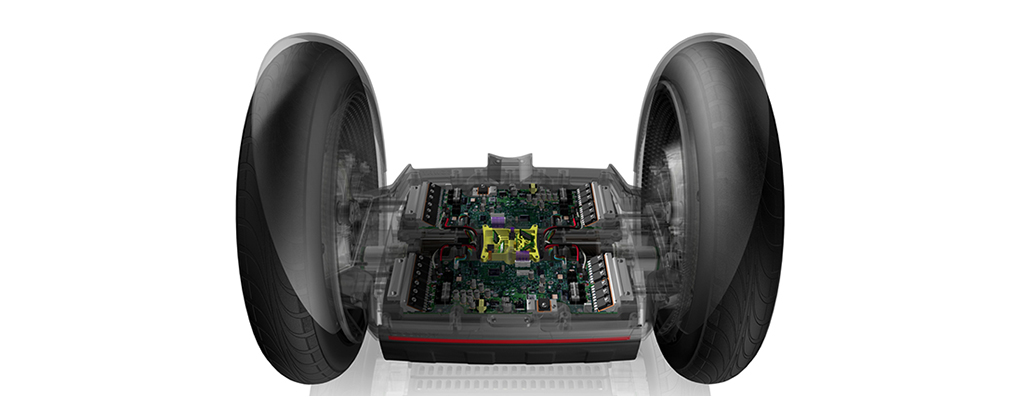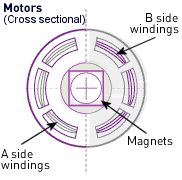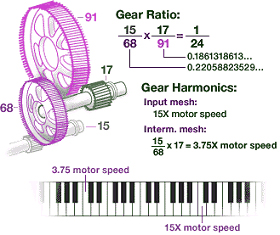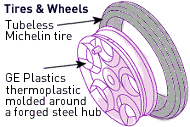
Please use our contact form to submit a query regarding the Segway PT, how to purchase or rent, event opportunities, or related questions.
Segway Switzerland
Eichzun 4
3800 Unterseen
Phone: +41 (0)33 442 80 00
E-Mail: welcome@segway.ch
Our office is open between 8 am and 5 pm on weekdays.

Technology
Overview of the propulsion system (BSA)
The Segway PT uses a redundant means of propulsion to be able to safely control the vehicle even in the case of a component malfunction. The system consists of the following primary components:
- A sensor module (Balance Sensor Assembly "BSA"), which includes a gyroscope and an acceleration measure and generates the signal for braking and acceleration commands. The module comprises two redundant systems that are controlled respectively by different control units and deliver sufficient data to steer and balance out the vehicle
- Two control units (Control Unit "CU"), welche je einen Mikroprozessor für die Kontrolle der beiden Motoren umfassen, sowie zwei unabhängige Kontrolleinheiten, um die Motoren zuverlässig mit Energie zu versorgen
- Two brushless electric DC motors, which each include two redundant electrical windings and are therefore able to propel each motor individually
- Two lithium ion saphion accus that deliver sufficient energy for steering and propulsion
Redundance ensures high operating safety
The system is redundantly designed to guarantee safe braking at all times. During normal use the control units and accumulator components share the workload to permit continuous operation in an efficient operating range. In the case of a partial system malfunction one accumulator and one control unit can regulate half the windings from each motor and thus maintain balance and steering ability. The vehicle will brake to a safe stop and subsequently be switched off.
In the case of a malfunction during the drive the Segway PT executes a safety shutdown, which brings the driver to a safe stop in around 10 seconds or less. If the malfunction subsequently still exists, the system will no longer start up. The Segway PT permits no further operation if only a part of the propulsion system is available.
Comprehensive self control of the systems
Each control unit is able to monitor the other via communication channels in the sensor module. These communication channels are optically isolated to prevent breakdown. Complete communication and energy connections are monitored at 100Hz (100 times per second).
When the Segway PT is switched on, the system is thoroughly checked through before the vehicle can be started. In the case that both propulsion systems are unavailable, the vehicle cannot be started.
Powerful motors also when braking
Instead of using mechanical braking, the Segway PT relies on controlled braking from the high performance, brushless DC motors, which reach or surpass the braking capacity of other small means of transportation. The energy generated upon braking is fed back to the accumulators via the integrated recuperation system.
Sensor Module (BSA)
The bond compound of balance sensors, produced by Silicon Sensing Systems, is an elegantly constructed, extremely hardy and exceedingly sensitive device.
This small cube of approximately 7.6 cm side length contains five fixed ring vibration and winding measure sensors (gyroscopes) that use the Coriolis effect to measure the turning speed. These minute rings are brought to vibration electromechanically. When they are turned, a small amount of power is generated, through which the internal sensor electronics are measured.

Each gyroscope is fixed at an angle that allows the measuring of different directions of movement. The Segway PT’s board computer continually compares the information from all five gyroscopes and measures whether any of the five sensors deliver faulty data. If this is the case, the computer continues working with the data from the remaining sensors until a controlled safety shutdown occurs.
Two inclinometers that are filled with electrolyte fluid provide information about the gravitation in the same manner that our inner ear works together with our balance sense. The sensor module is monitored by two independent microprocessors and for redundancy reasons is in divided into two systems. In fact the communication to both system components is optically executed to prevent transfer of electrical malfunction from one side to the other.
Control Units (CU)
Two sophisticated circuit boards from Delphi electronics provide the brain and the muscles for the system. Delphi Electronics were chosen as a partner for their experience in mass production of high quality automobile electronics for sophisticated applications such as airbags.

Each circuit board is fitted with a Texas Instruments signal processor that monitors the entire Segway PT system and checks 100 times per second for any malfunction or other conditions that require an immediate reaction. It reads the information from the balance sensors to determine whether the driver leans forwards or backwards. This information is supplied without time delay to conduct the energy from the accumulator through a set of 12 "high energy-high electricity-field effect transistors" (FET’s) to the motors. These calculations occur one hundred times per second and the motors are adjusted up to one thousand times per second, a reaction time that far exceeds human perception time. After a malfunction, each circuit board of the Segway PT can completely steer the other board. Each board is connected with the electrical circuits of both motors and under normal operating conditions, the processing power is divided.
Motors
The motors of the Segway PT are unique in many ways. Produced by Pacific Scientific, a business branch of Danaher, they are the most powerful motors that have ever been produced in their weight and size class. Both motors require 330 watts for continuous operation and produce a short time peak performance of up to 4 PS.

The motors use brushless servo-technology. This means there are no mechanical contacts that wear out and thereby reduce output. The magnets are comprised of an extremely powerful and rare earth metal: Neodym-Iron-Bor. Each motor is fitted with two independent windings, from which each of it’s own circuit boards are steered. Under normal conditions of use, the windings work parallel to each other and divide the workload. In the case of a malfunction the motor deactivates the malfunctioning winding and controls the remaining one to maintain control over the Segway PT until it is brought to a stop. The motor accurately calibrates the output from up to 8000 turns per minute, which enables a very high power level within a short range. By measuring the position of the magnets, redundant, contactless and analogue sensors give feedback from the motor to the control units. The motor axis is the only movable part.
Gearbox
The gearbox of the Segway PT, a joint development from Axicon Technologies and Segway is more comparable to a Swiss precision clock than a traditional automobile. A two-step system offers a 24:1 gear reduction that enables operation of the motor at a powerful and efficient speed level across the full range of speeds of the Segway PT.

Each gear step is cut in a spiral formed profile and this type of connection minimises noise and increases the maximum permissible load. The number of teeth on each gear level has been selected, so that non-integral gear ration achieved is. This means the teeth grip on a different gearing place on every turn and therefore the lifespan of the gearbox is increased. Segway engineers have developed the gearing teeth so that the emerging sounds lie exactly two musical octaves apart from each other. When the Segway PT moves, it makes music rather than noise. The gearbox is preassembled, lubricated and requires no further maintenance during the total lifespan of the Segway PT. It has been tested over thousands of kilometres under hard working conditions.
Tyres
Michelin was the first partner in the development of the Segway PT. The tyres of the Segway PT were specially developed for this vehicle and employ a unique compound of silicon dioxide instead of the traditionally used carbon based material. This offers increased stability and minimises markings, particularly on indoor floors. The tyres are fitted with special tubes and require a low tyre pressure. This special development minimises frictional resistance thereby increasing driving comfort.

The tyres are mounted on a similarly unique wheel for the PT i2: the wheels are composed of a highly developed fiberglass hardened thermoplastic, which was chosen in conjunction with GE Plastics. The composite material enables nominal weight and excellent durability while reducing noise from the propulsion system. Tyres for the PT x2 are the tubeless, low pressure tyres in the versions “Offroad” and “Turf”. As well as increased suspension, these tyres offer better traction properties on terrain. The offroad tyres can also be fitted with snow chains.
Batteries
The new Segway PT models are assembled with saphion lithium ion batteries. Segway chose to work with Valence Technology, the leading developers of efficient and safe accumulators. The base for the new accumulators is formed by Saphion ® technology (patented from Valence), which is made from phosphates. Saphion is stable and safe and therefore the ideal solution for daily use. It has a longer lifespan than the traditional NiMH accumulators.
The range is increased while the charging time is reduced. Every accu comprises a compound of high performance cells and a specially developed circuit board that permanently monitors the temperature and tension on the batteries from different positions.
The accu casing is sealed by a vibrating welding method, which forms the exterior of the compound into one single, consistent structure. The seal protects against moisture and remains so strong that it flawlessly stands up to complete and extreme testing. The accus’ integrated electronics enable "intelligent" charging. The owner plugs the Segway into a power point and the accumulator itself chooses the appropriate charging speed based on temperature, tension and current charge level. The accu is quickly charged and switches then into idle and maintenance modes. The Segway PT owner must spare no thought about timing - simply plug in and the rest happens automatically.
Under normal operating conditions the Segway PT reliably monitors both batteries and consistently discharges them. In the case of battery failure, the system can come safely to an emergency stop with only one battery.
Newsletter

Segway Switzerland
Eichzun 4, 3800 Unterseen
Phone: +41 (0)33 442 80 00
E-Mail: welcome@segway.ch


